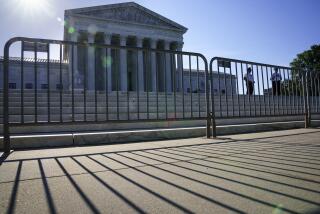‘The Supreme Court’ makes a brief for judiciary
The simplicity of the title and the fact that it comes in four one-hour installments signals that “The Supreme Court,” airing tonight and next Wednesday on PBS, is meant to be a serious, comprehensive and weighty thing -- like “The Civil War,” or “Baseball,” or “New York” before it, though it is not directed by anyone named Burns.
And as with those documentaries it views the parade of history through the prism of individuals, who shape the world and are shaped by it, so that the film is not just the story of an institution but of the nation and its times, its faults and obsessions.
Directed by Thomas Lennon, who also made “The Irish in America: Long Journey Home,” the film is kicked along by the rather excited commentary of a host of law and political science professors and from contextually glamorous contributions by Chief Justice John Roberts, retired Justice Sandra Day O’Connor and Judge Robert L. Carter who, with future Justice Thurgood Marshall, argued Brown vs. Board of Education on behalf of the NAACP.
Even at four hours, it is necessarily a thing of highlights, not a complete tour of the business of the court or even all its important personalities. What’s there is always breezy and interesting and, given the tortuousness of the law, surprisingly easy to follow. And yet (like any four-hour documentary) it is full of more facts than the mind can easily hold. If you are like me, you will need to watch it more than once to feel you can discuss it halfway intelligently or even get the names straight.
A few things do stick in the mind:
The Supreme Court as we know it -- a body coequal to the legislative and administrative branches of government, with the power to overturn a law that does not accord with its interpretation of the Constitution -- was not described as such constitutionally but more or less invented by Chief Justice John Marshall in 1803. (A nice irony “original intent” hard-liners might want to overlook.) The court, which early on met in “an old potato hole of a place,” has continued to define and increase its own power and glory in the years since, to the point that it decided the 2000 presidential election (Chief Justice Rehnquist, usually a states’ rights federalist, taking Bush vs. Gore away from the Supreme Court of Florida).
There was a justice named Hamburger and a justice named Frankfurter.
And Justice Hugo Black was so reviled by the folks back home in Alabama for his dogged support of civil rights that in 1959 the state resolved that he could not be buried there.
No body that could issue the Dred Scott decision can be called infallibly wise or reliably just, and yet the necessity to cogently explain one’s decisions and (usually, but not always) back them up with law or precedent or some clever reading thereof -- something not required of the other branches of the government -- seems to elicit a certain even-handedness from those who serve on it. The court remains unpredictable. Justice Harry Blackmun, appointed by Richard Nixon, wrote the opinion in Roe vs. Wade; Sandra Day O’Connor, expected to echo Rehnquist (whom she’d dated in law school), turned out a moderate swing vote. As of this writing, abortion is still legal and there is no prayer in public school. As of this writing.
David Straithairn narrates with natural folksy gravitas.
*
‘The Supreme Court’
Where: KCET
When: 9 to 11 tonight
Rating: TV-PG (may be unsuitable for young children)
More to Read
Only good movies
Get the Indie Focus newsletter, Mark Olsen's weekly guide to the world of cinema.
You may occasionally receive promotional content from the Los Angeles Times.











